Literature Review of Product Branding in a Company Setting
VerifiedAdded on 2020/03/16
|7
|1983
|170
Literature Review
AI Summary
This literature review examines the critical role of product branding in contemporary marketing, emphasizing its impact on customer perception and company success. The review explores the concept of branding as a dynamic process influenced by consumer behavior, highlighting its function in creating a mental image of an organization. It delves into key aspects such as brand equity, customer loyalty, and competitive advantage, illustrating how effective branding strategies can enhance a company's market position. The review analyzes how innovation and technology contribute to brand success, emphasizing the importance of understanding customer needs and integrating branding with public relations. Furthermore, it differentiates branding from marketing, underscoring branding's long-term influence on customer loyalty and its role in establishing a company's identity and values. The review also discusses the various methods through which branding is accomplished, including promotion, product innovation, and visual character development, concluding with the essentiality of branding for business survival and success.
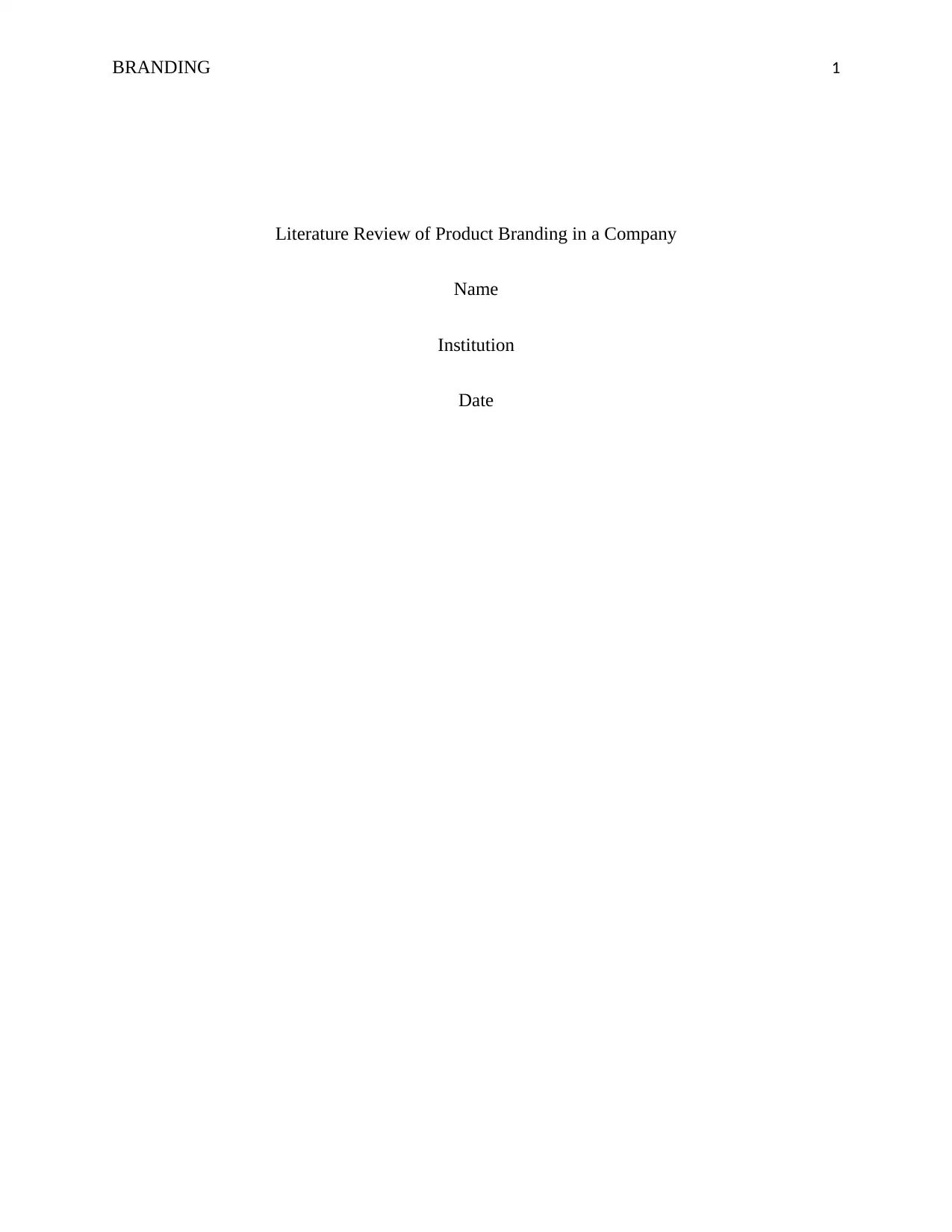
BRANDING 1
Literature Review of Product Branding in a Company
Name
Institution
Date
Literature Review of Product Branding in a Company
Name
Institution
Date
Paraphrase This Document
Need a fresh take? Get an instant paraphrase of this document with our AI Paraphraser
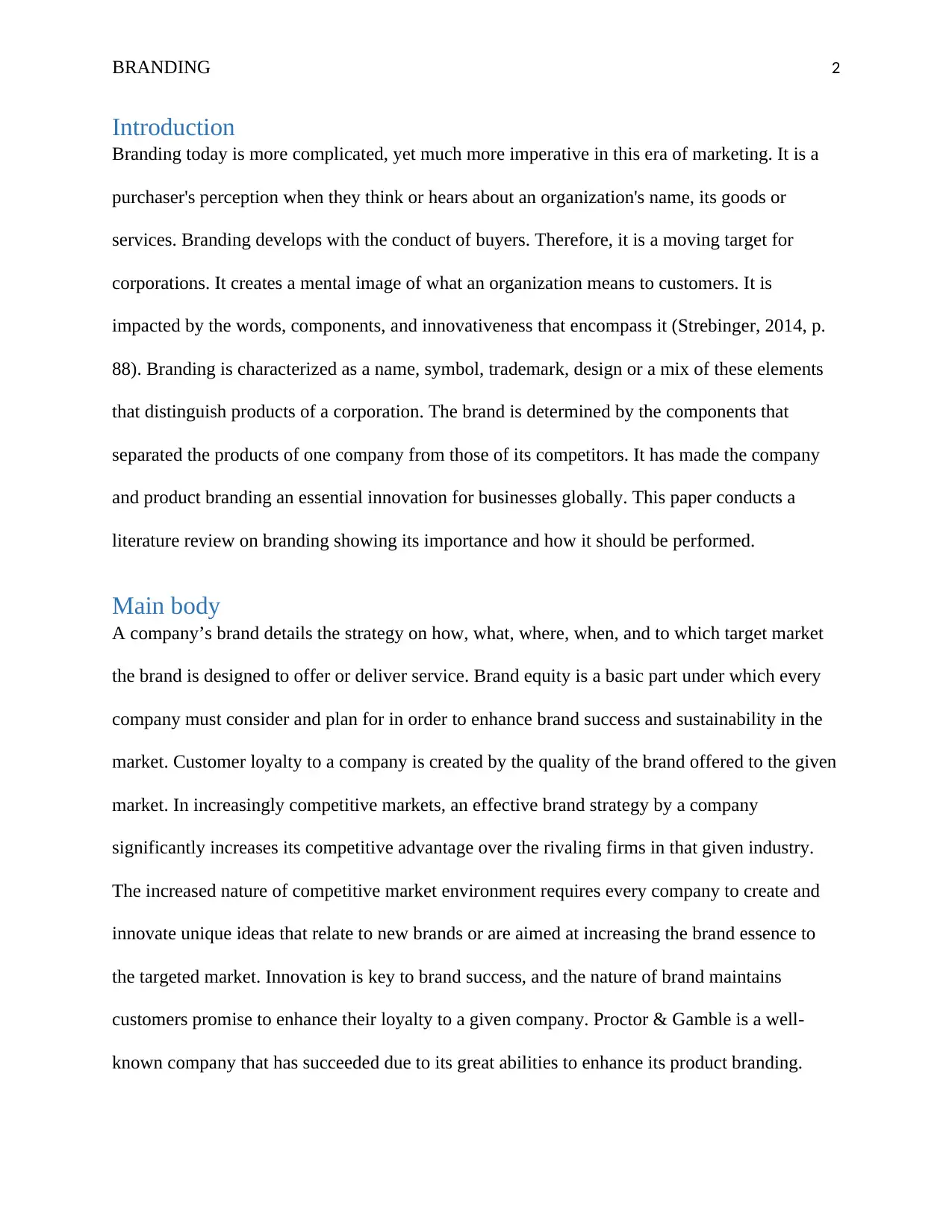
BRANDING 2
Introduction
Branding today is more complicated, yet much more imperative in this era of marketing. It is a
purchaser's perception when they think or hears about an organization's name, its goods or
services. Branding develops with the conduct of buyers. Therefore, it is a moving target for
corporations. It creates a mental image of what an organization means to customers. It is
impacted by the words, components, and innovativeness that encompass it (Strebinger, 2014, p.
88). Branding is characterized as a name, symbol, trademark, design or a mix of these elements
that distinguish products of a corporation. The brand is determined by the components that
separated the products of one company from those of its competitors. It has made the company
and product branding an essential innovation for businesses globally. This paper conducts a
literature review on branding showing its importance and how it should be performed.
Main body
A company’s brand details the strategy on how, what, where, when, and to which target market
the brand is designed to offer or deliver service. Brand equity is a basic part under which every
company must consider and plan for in order to enhance brand success and sustainability in the
market. Customer loyalty to a company is created by the quality of the brand offered to the given
market. In increasingly competitive markets, an effective brand strategy by a company
significantly increases its competitive advantage over the rivaling firms in that given industry.
The increased nature of competitive market environment requires every company to create and
innovate unique ideas that relate to new brands or are aimed at increasing the brand essence to
the targeted market. Innovation is key to brand success, and the nature of brand maintains
customers promise to enhance their loyalty to a given company. Proctor & Gamble is a well-
known company that has succeeded due to its great abilities to enhance its product branding.
Introduction
Branding today is more complicated, yet much more imperative in this era of marketing. It is a
purchaser's perception when they think or hears about an organization's name, its goods or
services. Branding develops with the conduct of buyers. Therefore, it is a moving target for
corporations. It creates a mental image of what an organization means to customers. It is
impacted by the words, components, and innovativeness that encompass it (Strebinger, 2014, p.
88). Branding is characterized as a name, symbol, trademark, design or a mix of these elements
that distinguish products of a corporation. The brand is determined by the components that
separated the products of one company from those of its competitors. It has made the company
and product branding an essential innovation for businesses globally. This paper conducts a
literature review on branding showing its importance and how it should be performed.
Main body
A company’s brand details the strategy on how, what, where, when, and to which target market
the brand is designed to offer or deliver service. Brand equity is a basic part under which every
company must consider and plan for in order to enhance brand success and sustainability in the
market. Customer loyalty to a company is created by the quality of the brand offered to the given
market. In increasingly competitive markets, an effective brand strategy by a company
significantly increases its competitive advantage over the rivaling firms in that given industry.
The increased nature of competitive market environment requires every company to create and
innovate unique ideas that relate to new brands or are aimed at increasing the brand essence to
the targeted market. Innovation is key to brand success, and the nature of brand maintains
customers promise to enhance their loyalty to a given company. Proctor & Gamble is a well-
known company that has succeeded due to its great abilities to enhance its product branding.
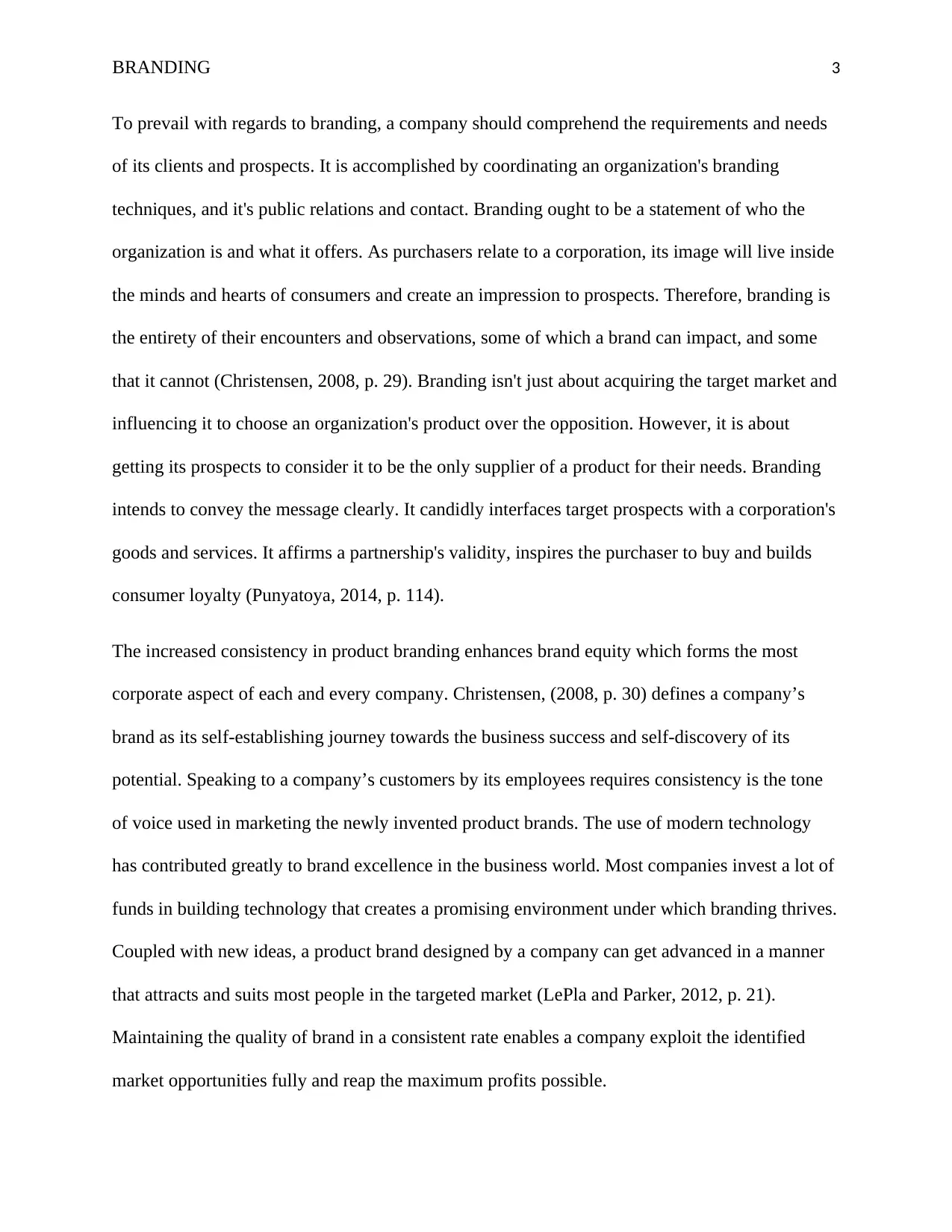
BRANDING 3
To prevail with regards to branding, a company should comprehend the requirements and needs
of its clients and prospects. It is accomplished by coordinating an organization's branding
techniques, and it's public relations and contact. Branding ought to be a statement of who the
organization is and what it offers. As purchasers relate to a corporation, its image will live inside
the minds and hearts of consumers and create an impression to prospects. Therefore, branding is
the entirety of their encounters and observations, some of which a brand can impact, and some
that it cannot (Christensen, 2008, p. 29). Branding isn't just about acquiring the target market and
influencing it to choose an organization's product over the opposition. However, it is about
getting its prospects to consider it to be the only supplier of a product for their needs. Branding
intends to convey the message clearly. It candidly interfaces target prospects with a corporation's
goods and services. It affirms a partnership's validity, inspires the purchaser to buy and builds
consumer loyalty (Punyatoya, 2014, p. 114).
The increased consistency in product branding enhances brand equity which forms the most
corporate aspect of each and every company. Christensen, (2008, p. 30) defines a company’s
brand as its self-establishing journey towards the business success and self-discovery of its
potential. Speaking to a company’s customers by its employees requires consistency is the tone
of voice used in marketing the newly invented product brands. The use of modern technology
has contributed greatly to brand excellence in the business world. Most companies invest a lot of
funds in building technology that creates a promising environment under which branding thrives.
Coupled with new ideas, a product brand designed by a company can get advanced in a manner
that attracts and suits most people in the targeted market (LePla and Parker, 2012, p. 21).
Maintaining the quality of brand in a consistent rate enables a company exploit the identified
market opportunities fully and reap the maximum profits possible.
To prevail with regards to branding, a company should comprehend the requirements and needs
of its clients and prospects. It is accomplished by coordinating an organization's branding
techniques, and it's public relations and contact. Branding ought to be a statement of who the
organization is and what it offers. As purchasers relate to a corporation, its image will live inside
the minds and hearts of consumers and create an impression to prospects. Therefore, branding is
the entirety of their encounters and observations, some of which a brand can impact, and some
that it cannot (Christensen, 2008, p. 29). Branding isn't just about acquiring the target market and
influencing it to choose an organization's product over the opposition. However, it is about
getting its prospects to consider it to be the only supplier of a product for their needs. Branding
intends to convey the message clearly. It candidly interfaces target prospects with a corporation's
goods and services. It affirms a partnership's validity, inspires the purchaser to buy and builds
consumer loyalty (Punyatoya, 2014, p. 114).
The increased consistency in product branding enhances brand equity which forms the most
corporate aspect of each and every company. Christensen, (2008, p. 30) defines a company’s
brand as its self-establishing journey towards the business success and self-discovery of its
potential. Speaking to a company’s customers by its employees requires consistency is the tone
of voice used in marketing the newly invented product brands. The use of modern technology
has contributed greatly to brand excellence in the business world. Most companies invest a lot of
funds in building technology that creates a promising environment under which branding thrives.
Coupled with new ideas, a product brand designed by a company can get advanced in a manner
that attracts and suits most people in the targeted market (LePla and Parker, 2012, p. 21).
Maintaining the quality of brand in a consistent rate enables a company exploit the identified
market opportunities fully and reap the maximum profits possible.
⊘ This is a preview!⊘
Do you want full access?
Subscribe today to unlock all pages.

Trusted by 1+ million students worldwide
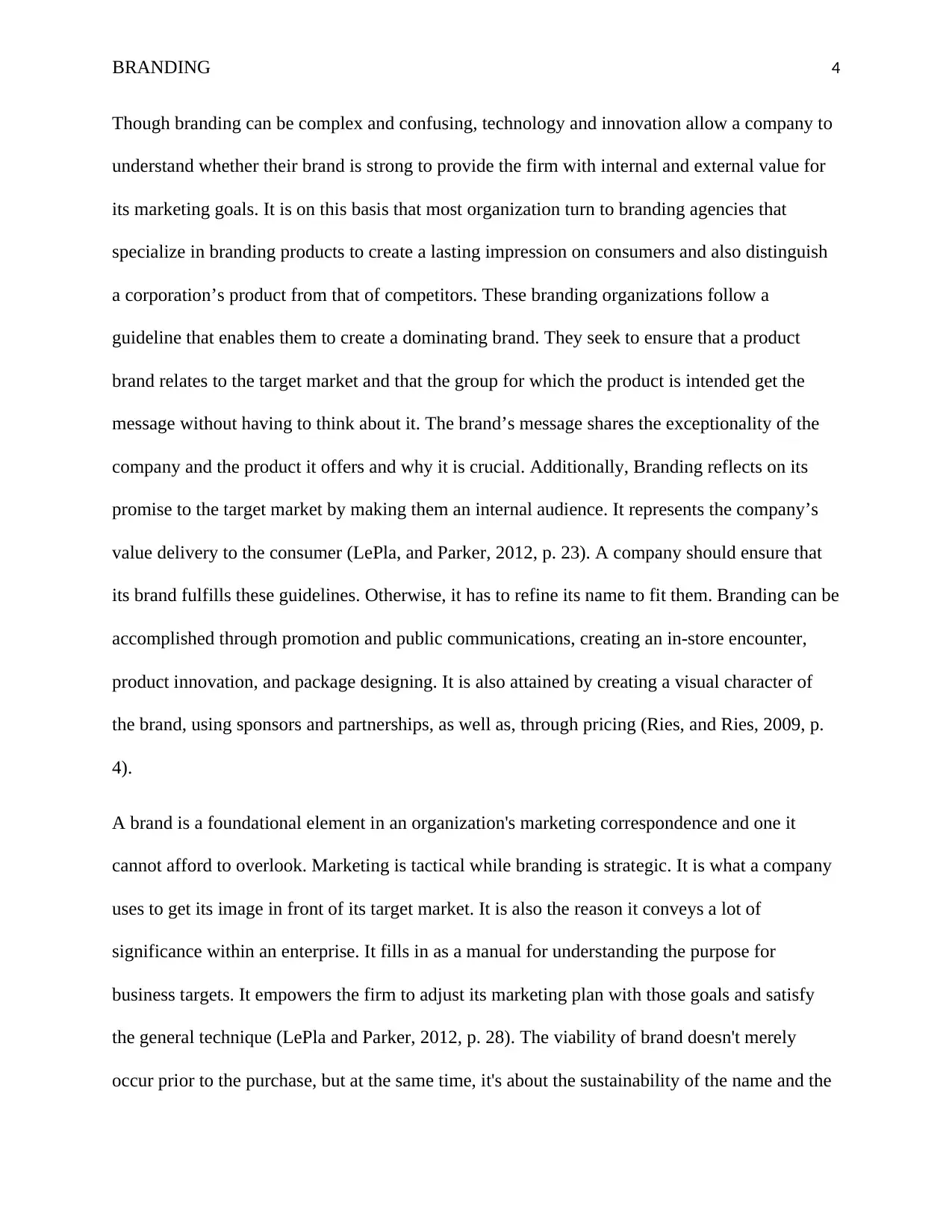
BRANDING 4
Though branding can be complex and confusing, technology and innovation allow a company to
understand whether their brand is strong to provide the firm with internal and external value for
its marketing goals. It is on this basis that most organization turn to branding agencies that
specialize in branding products to create a lasting impression on consumers and also distinguish
a corporation’s product from that of competitors. These branding organizations follow a
guideline that enables them to create a dominating brand. They seek to ensure that a product
brand relates to the target market and that the group for which the product is intended get the
message without having to think about it. The brand’s message shares the exceptionality of the
company and the product it offers and why it is crucial. Additionally, Branding reflects on its
promise to the target market by making them an internal audience. It represents the company’s
value delivery to the consumer (LePla, and Parker, 2012, p. 23). A company should ensure that
its brand fulfills these guidelines. Otherwise, it has to refine its name to fit them. Branding can be
accomplished through promotion and public communications, creating an in-store encounter,
product innovation, and package designing. It is also attained by creating a visual character of
the brand, using sponsors and partnerships, as well as, through pricing (Ries, and Ries, 2009, p.
4).
A brand is a foundational element in an organization's marketing correspondence and one it
cannot afford to overlook. Marketing is tactical while branding is strategic. It is what a company
uses to get its image in front of its target market. It is also the reason it conveys a lot of
significance within an enterprise. It fills in as a manual for understanding the purpose for
business targets. It empowers the firm to adjust its marketing plan with those goals and satisfy
the general technique (LePla and Parker, 2012, p. 28). The viability of brand doesn't merely
occur prior to the purchase, but at the same time, it's about the sustainability of the name and the
Though branding can be complex and confusing, technology and innovation allow a company to
understand whether their brand is strong to provide the firm with internal and external value for
its marketing goals. It is on this basis that most organization turn to branding agencies that
specialize in branding products to create a lasting impression on consumers and also distinguish
a corporation’s product from that of competitors. These branding organizations follow a
guideline that enables them to create a dominating brand. They seek to ensure that a product
brand relates to the target market and that the group for which the product is intended get the
message without having to think about it. The brand’s message shares the exceptionality of the
company and the product it offers and why it is crucial. Additionally, Branding reflects on its
promise to the target market by making them an internal audience. It represents the company’s
value delivery to the consumer (LePla, and Parker, 2012, p. 23). A company should ensure that
its brand fulfills these guidelines. Otherwise, it has to refine its name to fit them. Branding can be
accomplished through promotion and public communications, creating an in-store encounter,
product innovation, and package designing. It is also attained by creating a visual character of
the brand, using sponsors and partnerships, as well as, through pricing (Ries, and Ries, 2009, p.
4).
A brand is a foundational element in an organization's marketing correspondence and one it
cannot afford to overlook. Marketing is tactical while branding is strategic. It is what a company
uses to get its image in front of its target market. It is also the reason it conveys a lot of
significance within an enterprise. It fills in as a manual for understanding the purpose for
business targets. It empowers the firm to adjust its marketing plan with those goals and satisfy
the general technique (LePla and Parker, 2012, p. 28). The viability of brand doesn't merely
occur prior to the purchase, but at the same time, it's about the sustainability of the name and the
Paraphrase This Document
Need a fresh take? Get an instant paraphrase of this document with our AI Paraphraser
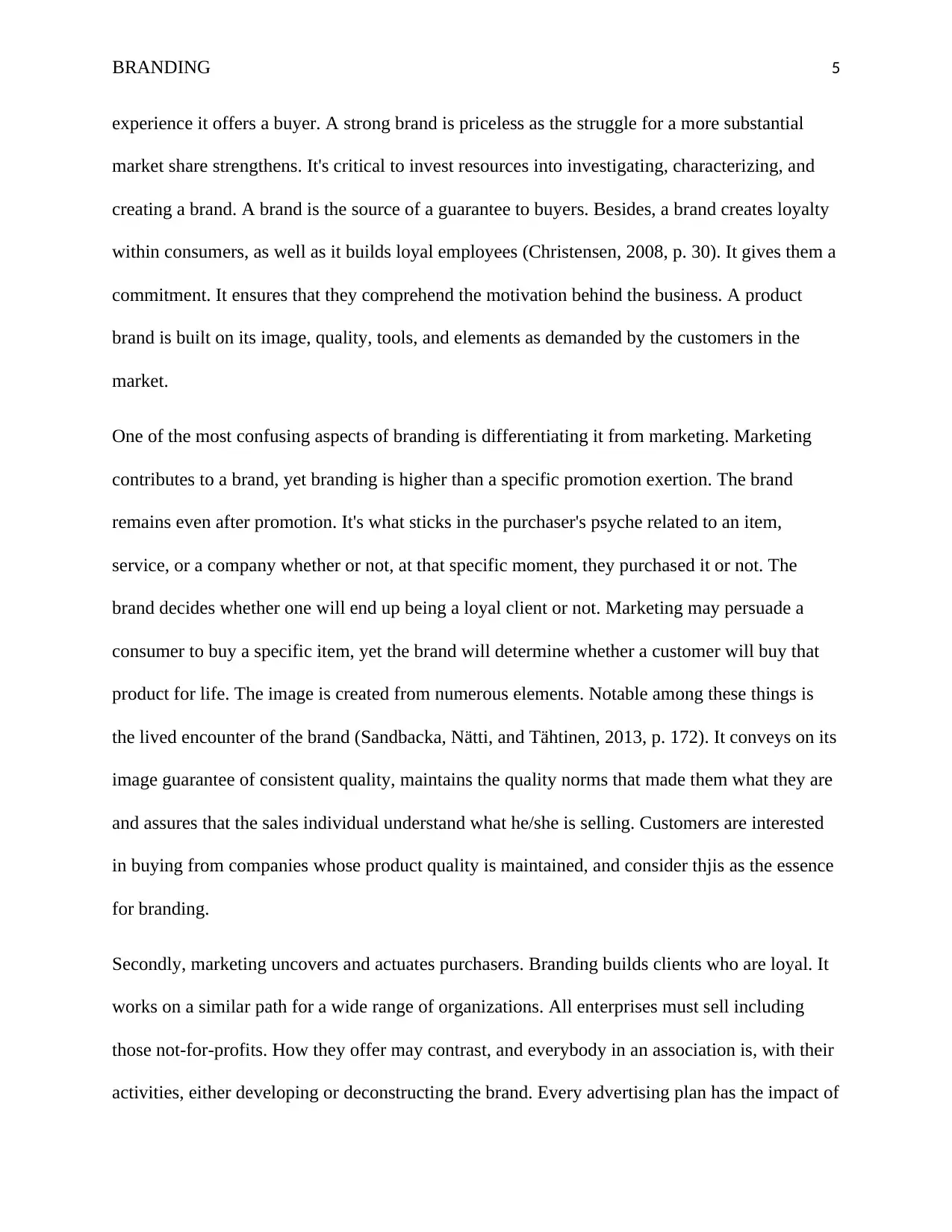
BRANDING 5
experience it offers a buyer. A strong brand is priceless as the struggle for a more substantial
market share strengthens. It's critical to invest resources into investigating, characterizing, and
creating a brand. A brand is the source of a guarantee to buyers. Besides, a brand creates loyalty
within consumers, as well as it builds loyal employees (Christensen, 2008, p. 30). It gives them a
commitment. It ensures that they comprehend the motivation behind the business. A product
brand is built on its image, quality, tools, and elements as demanded by the customers in the
market.
One of the most confusing aspects of branding is differentiating it from marketing. Marketing
contributes to a brand, yet branding is higher than a specific promotion exertion. The brand
remains even after promotion. It's what sticks in the purchaser's psyche related to an item,
service, or a company whether or not, at that specific moment, they purchased it or not. The
brand decides whether one will end up being a loyal client or not. Marketing may persuade a
consumer to buy a specific item, yet the brand will determine whether a customer will buy that
product for life. The image is created from numerous elements. Notable among these things is
the lived encounter of the brand (Sandbacka, Nätti, and Tähtinen, 2013, p. 172). It conveys on its
image guarantee of consistent quality, maintains the quality norms that made them what they are
and assures that the sales individual understand what he/she is selling. Customers are interested
in buying from companies whose product quality is maintained, and consider thjis as the essence
for branding.
Secondly, marketing uncovers and actuates purchasers. Branding builds clients who are loyal. It
works on a similar path for a wide range of organizations. All enterprises must sell including
those not-for-profits. How they offer may contrast, and everybody in an association is, with their
activities, either developing or deconstructing the brand. Every advertising plan has the impact of
experience it offers a buyer. A strong brand is priceless as the struggle for a more substantial
market share strengthens. It's critical to invest resources into investigating, characterizing, and
creating a brand. A brand is the source of a guarantee to buyers. Besides, a brand creates loyalty
within consumers, as well as it builds loyal employees (Christensen, 2008, p. 30). It gives them a
commitment. It ensures that they comprehend the motivation behind the business. A product
brand is built on its image, quality, tools, and elements as demanded by the customers in the
market.
One of the most confusing aspects of branding is differentiating it from marketing. Marketing
contributes to a brand, yet branding is higher than a specific promotion exertion. The brand
remains even after promotion. It's what sticks in the purchaser's psyche related to an item,
service, or a company whether or not, at that specific moment, they purchased it or not. The
brand decides whether one will end up being a loyal client or not. Marketing may persuade a
consumer to buy a specific item, yet the brand will determine whether a customer will buy that
product for life. The image is created from numerous elements. Notable among these things is
the lived encounter of the brand (Sandbacka, Nätti, and Tähtinen, 2013, p. 172). It conveys on its
image guarantee of consistent quality, maintains the quality norms that made them what they are
and assures that the sales individual understand what he/she is selling. Customers are interested
in buying from companies whose product quality is maintained, and consider thjis as the essence
for branding.
Secondly, marketing uncovers and actuates purchasers. Branding builds clients who are loyal. It
works on a similar path for a wide range of organizations. All enterprises must sell including
those not-for-profits. How they offer may contrast, and everybody in an association is, with their
activities, either developing or deconstructing the brand. Every advertising plan has the impact of
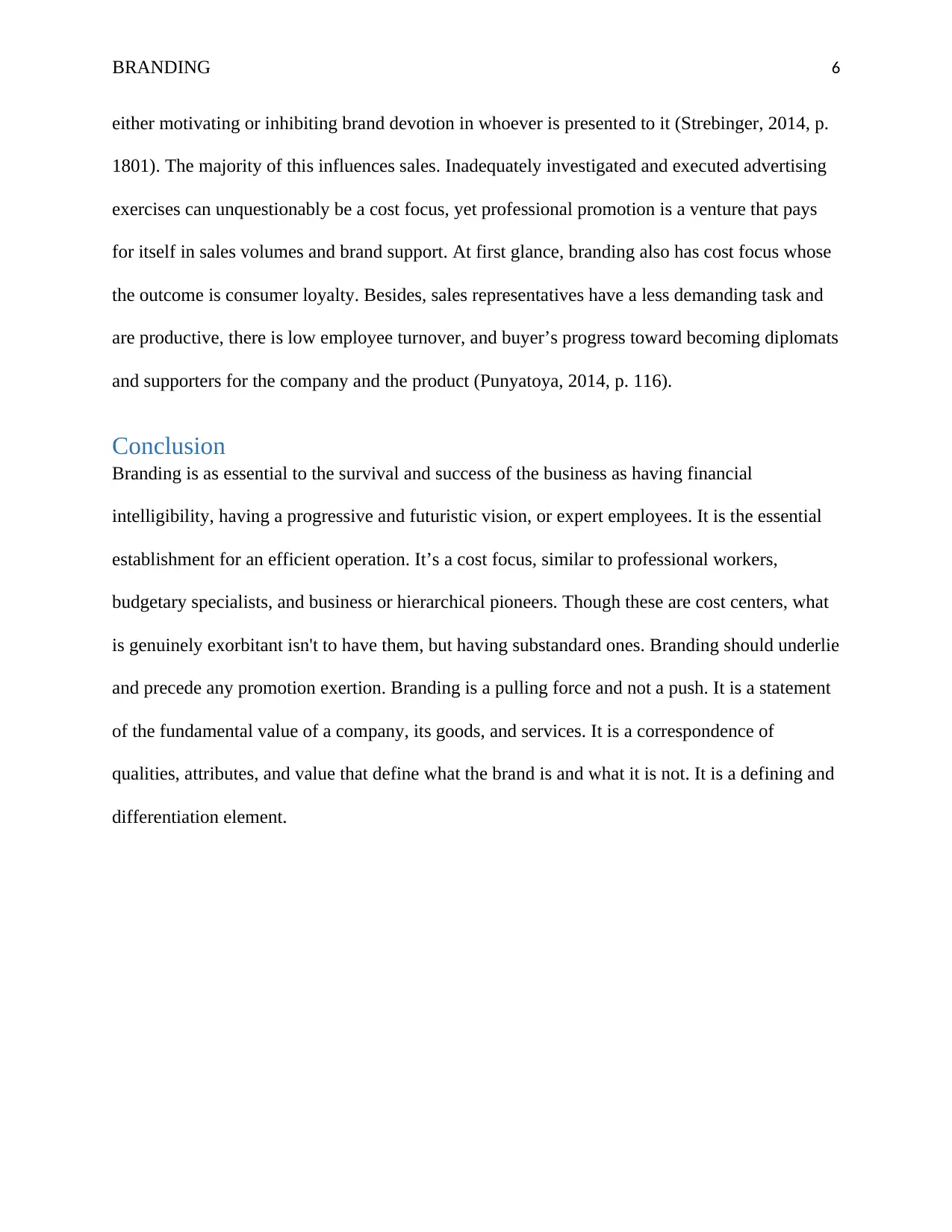
BRANDING 6
either motivating or inhibiting brand devotion in whoever is presented to it (Strebinger, 2014, p.
1801). The majority of this influences sales. Inadequately investigated and executed advertising
exercises can unquestionably be a cost focus, yet professional promotion is a venture that pays
for itself in sales volumes and brand support. At first glance, branding also has cost focus whose
the outcome is consumer loyalty. Besides, sales representatives have a less demanding task and
are productive, there is low employee turnover, and buyer’s progress toward becoming diplomats
and supporters for the company and the product (Punyatoya, 2014, p. 116).
Conclusion
Branding is as essential to the survival and success of the business as having financial
intelligibility, having a progressive and futuristic vision, or expert employees. It is the essential
establishment for an efficient operation. It’s a cost focus, similar to professional workers,
budgetary specialists, and business or hierarchical pioneers. Though these are cost centers, what
is genuinely exorbitant isn't to have them, but having substandard ones. Branding should underlie
and precede any promotion exertion. Branding is a pulling force and not a push. It is a statement
of the fundamental value of a company, its goods, and services. It is a correspondence of
qualities, attributes, and value that define what the brand is and what it is not. It is a defining and
differentiation element.
either motivating or inhibiting brand devotion in whoever is presented to it (Strebinger, 2014, p.
1801). The majority of this influences sales. Inadequately investigated and executed advertising
exercises can unquestionably be a cost focus, yet professional promotion is a venture that pays
for itself in sales volumes and brand support. At first glance, branding also has cost focus whose
the outcome is consumer loyalty. Besides, sales representatives have a less demanding task and
are productive, there is low employee turnover, and buyer’s progress toward becoming diplomats
and supporters for the company and the product (Punyatoya, 2014, p. 116).
Conclusion
Branding is as essential to the survival and success of the business as having financial
intelligibility, having a progressive and futuristic vision, or expert employees. It is the essential
establishment for an efficient operation. It’s a cost focus, similar to professional workers,
budgetary specialists, and business or hierarchical pioneers. Though these are cost centers, what
is genuinely exorbitant isn't to have them, but having substandard ones. Branding should underlie
and precede any promotion exertion. Branding is a pulling force and not a push. It is a statement
of the fundamental value of a company, its goods, and services. It is a correspondence of
qualities, attributes, and value that define what the brand is and what it is not. It is a defining and
differentiation element.
⊘ This is a preview!⊘
Do you want full access?
Subscribe today to unlock all pages.

Trusted by 1+ million students worldwide
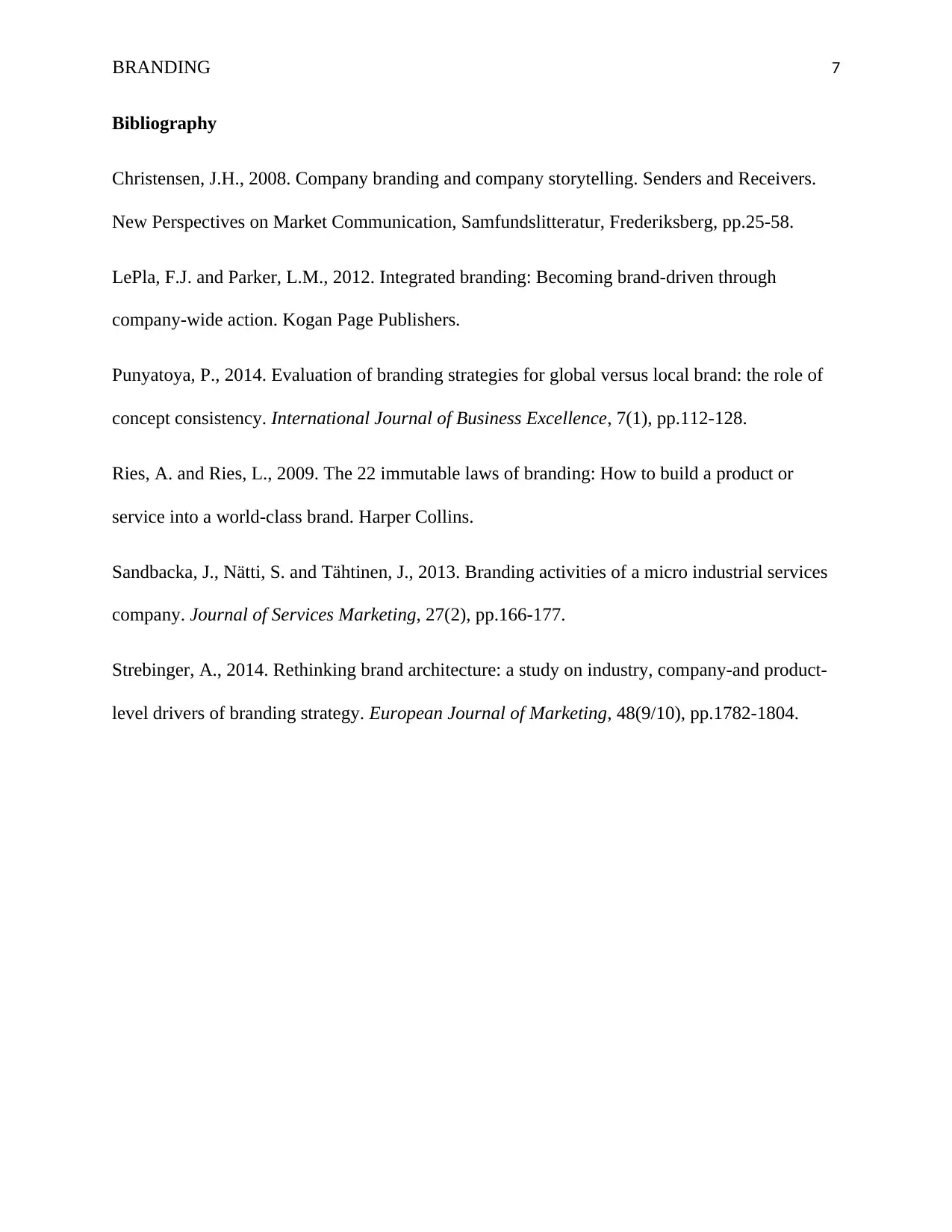
BRANDING 7
Bibliography
Christensen, J.H., 2008. Company branding and company storytelling. Senders and Receivers.
New Perspectives on Market Communication, Samfundslitteratur, Frederiksberg, pp.25-58.
LePla, F.J. and Parker, L.M., 2012. Integrated branding: Becoming brand-driven through
company-wide action. Kogan Page Publishers.
Punyatoya, P., 2014. Evaluation of branding strategies for global versus local brand: the role of
concept consistency. International Journal of Business Excellence, 7(1), pp.112-128.
Ries, A. and Ries, L., 2009. The 22 immutable laws of branding: How to build a product or
service into a world-class brand. Harper Collins.
Sandbacka, J., Nätti, S. and Tähtinen, J., 2013. Branding activities of a micro industrial services
company. Journal of Services Marketing, 27(2), pp.166-177.
Strebinger, A., 2014. Rethinking brand architecture: a study on industry, company-and product-
level drivers of branding strategy. European Journal of Marketing, 48(9/10), pp.1782-1804.
Bibliography
Christensen, J.H., 2008. Company branding and company storytelling. Senders and Receivers.
New Perspectives on Market Communication, Samfundslitteratur, Frederiksberg, pp.25-58.
LePla, F.J. and Parker, L.M., 2012. Integrated branding: Becoming brand-driven through
company-wide action. Kogan Page Publishers.
Punyatoya, P., 2014. Evaluation of branding strategies for global versus local brand: the role of
concept consistency. International Journal of Business Excellence, 7(1), pp.112-128.
Ries, A. and Ries, L., 2009. The 22 immutable laws of branding: How to build a product or
service into a world-class brand. Harper Collins.
Sandbacka, J., Nätti, S. and Tähtinen, J., 2013. Branding activities of a micro industrial services
company. Journal of Services Marketing, 27(2), pp.166-177.
Strebinger, A., 2014. Rethinking brand architecture: a study on industry, company-and product-
level drivers of branding strategy. European Journal of Marketing, 48(9/10), pp.1782-1804.
1 out of 7
Related Documents
Your All-in-One AI-Powered Toolkit for Academic Success.
+13062052269
info@desklib.com
Available 24*7 on WhatsApp / Email
![[object Object]](/_next/static/media/star-bottom.7253800d.svg)
Unlock your academic potential
Copyright © 2020–2025 A2Z Services. All Rights Reserved. Developed and managed by ZUCOL.





